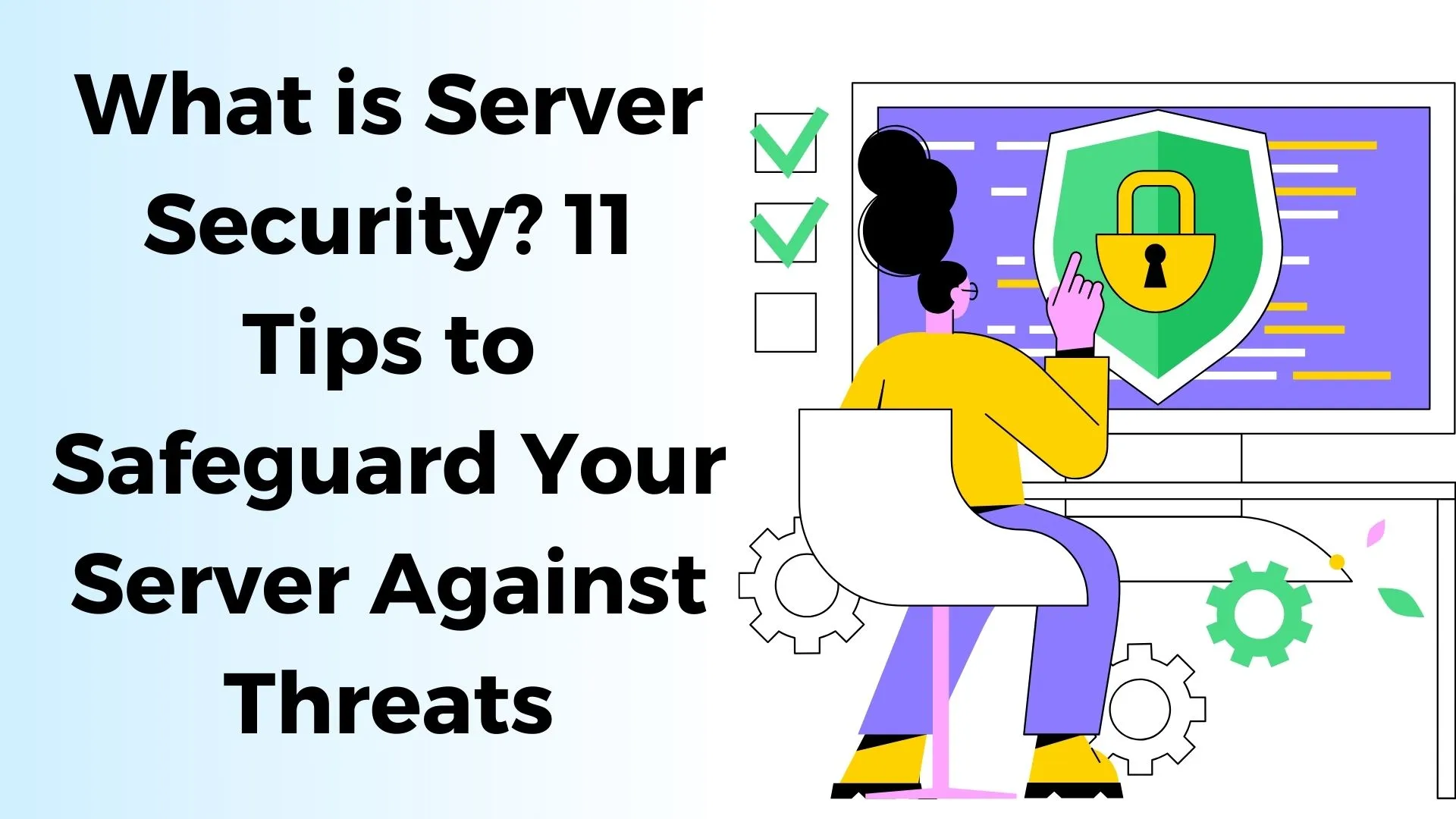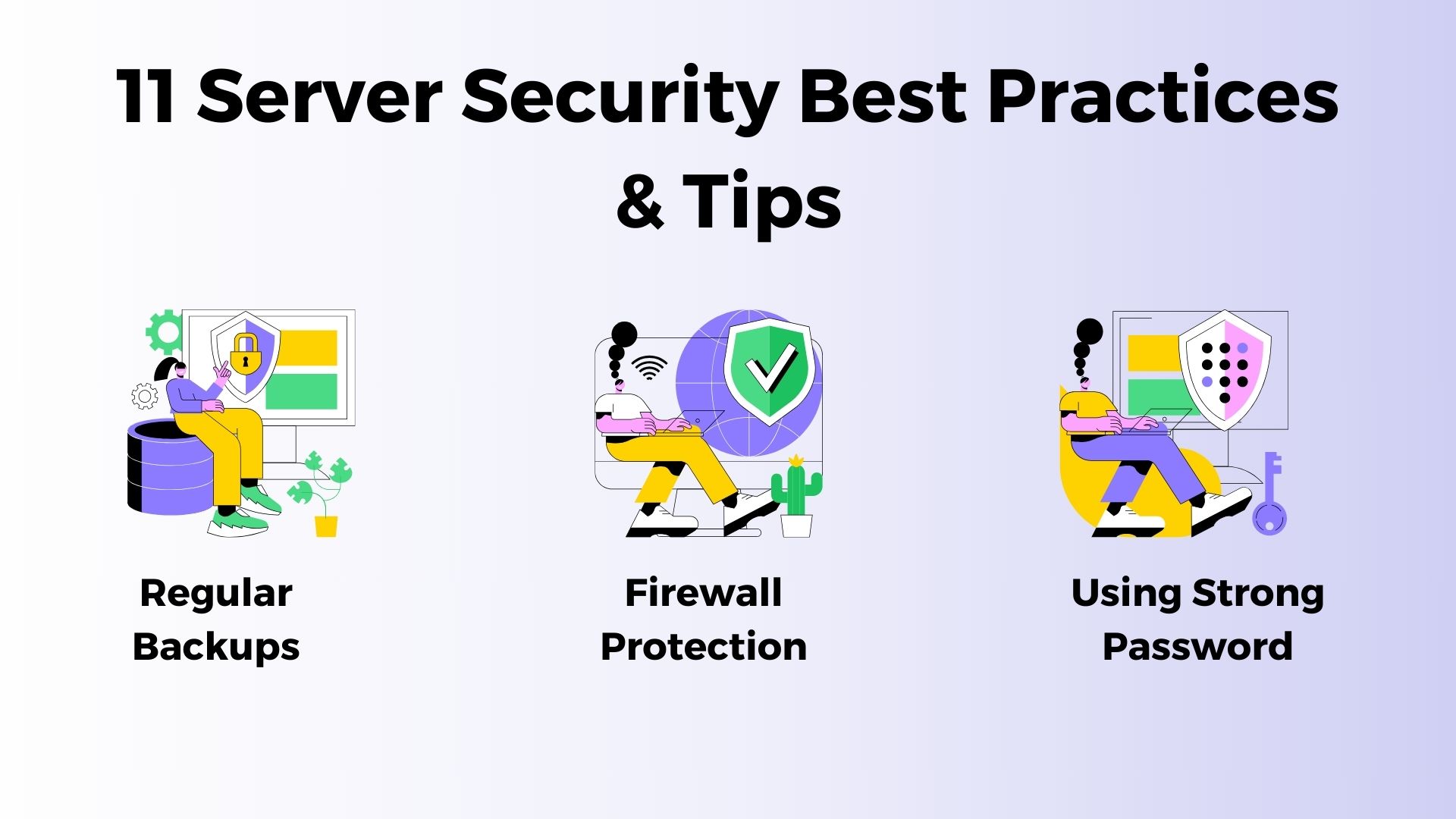Securing servers is a crucial task for system admins to protect important data from ever-evolving online threats. By following a server security checklist, businesses can minimize vulnerabilities and strengthen their server’s protection.
In this article, we’ll outline 11 key practices and top tips to ensure robust server security.
What is Server Security?

Server management security involves the steps taken to keep a server safe from unauthorized access and harmful attacks. It’s about using the right security methods to stop hackers or other threats from causing damage.
The main goal of server security is to keep everything on the server safe, including data and services. This safety is achieved through a mix of administrative steps and technical actions. Some of these actions include:
- Using strong cybersecurity tools.
- Setting up hard-to-guess passwords.
- Turning off any services or ports that aren’t needed.
- Controlling who has access to what.
- Keeping an eye on server activity with monitoring tools.
But server security isn’t just about technical stuff. Modern businesses also use security checks and risk assessments to find and fix any weak points in their systems.
Is Sever Security Important?
64 percent of Americans have never checked to see if they were affected by a data breach (source). The threats businesses face online are real and significant. Beyond just losing money, a breach in security can harm a company’s reputation for a long time. Since servers hold sensitive information like personal data, credit card details, and confidential business information, they’re prime targets for hackers.
To protect against these risks, having strong server security is essential. When cybercriminals find outdated software, they see it as an opportunity to break in. Regularly updating and maintaining server security not only helps in preventing unauthorized access but also ensures that your business stays compliant with regulations. Ultimately, prioritizing server security builds trust and keeps operations running smoothly.
Some Common Server Security Issues
Both businesses and individuals often wonder about the best ways to protect their servers. The answer can vary based on the existing IT setup, and with the tech landscape we have today, new security gaps appear frequently. It’s crucial to address these vulnerabilities promptly to prevent potential breaches. Here are some key aspects to focus on for server security:
- Passwords: Using strong passwords is essential. Weak ones are an open invitation for hackers.
- Outdated Software: All software has its flaws, and older versions can be especially vulnerable since cybercriminals are familiar with their weaknesses.
- Patches: Keeping software updated with the latest patches is crucial for maintaining server security.
- Network Ports: Properly configuring network ports is vital. Poor setups can be exploited by attackers.
- Unused Accounts: For better security, it’s wise to remove any user accounts that are no longer in use.
- Physical Security: Regardless of the OS, be it Windows or Linux, the physical security of server hardware is crucial. Preventing unauthorized physical access is a fundamental security measure.
By addressing these common areas, one can at least be secured from common open threats. However, some advanced measures can be taken to prevent server security that we will discuss in the coming section.
11 Server Security Best Practices & Tips

The following tips offer a thorough guide to your server’s defenses and ensure optimal security measures:
Keep Software and Operating System Up to Date
Keeping your software and operating system up-to-date is crucial for optimal security. By staying updated, you protect your system from known threats and benefit from the latest security fixes.
Regular updates help close off entry points that hackers might target. Whether you’re using Linux or Windows, ensuring your server’s operating system is always updated is a must. Plus, these updates often bring new security features that further fortify your server’s defenses.
Regular Backups
Maintaining consistent server backups is key for top-notch security. This approach acts as a safety net against data loss due to breaches or technical issues.
When backing up, using encryption is vital. This ensures an added level of security, especially for any sensitive data stored on the server.
Having a backup plan is a smart move for data protection. This way you can have a checklist and periodic backups taken so that you are safe in the worst of the conditions.
Limited User Access
Restricting access plays a pivotal role in maintaining security. This means only allowing necessary permissions to users and strictly controlling who has access.
Implementing strong authentication methods, such as two-factor authentication, can further tighten security. It’s wise to regularly review and update access controls, removing any unnecessary privileges or outdated accounts.
Most servers come with a root user that has extensive command access, making it a prime target for cyberattacks. To step up security, consider disabling direct root login via SSH. Instead, create a specialized user account specifically for administrative tasks. This approach not only limits the potential damage but also reduces the server’s vulnerability to threats.
SSL Certificate
SSL certificates (Secure Socket Layer), along with TLS (Transport Layer Security), are fundamental components of server security. These certificates guarantee encrypted communication between the server and its clients, enhancing the security of data transfers online.
By encrypting the data, they act as a barrier against unauthorized access and potential breaches, playing a pivotal role in safeguarding sensitive information.
Security with VPN
Utilizing a Virtual Private Network (VPN) provides an extra layer of protection by encrypting the data flow between your device and the server.
This encryption establishes a secure tunnel, preventing cybercriminals from accessing or intercepting critical data. When paired with SSL certificates, VPNs further strengthen server security, fortifying the online ecosystem and enhancing data protection measures.
Using Strong Password
Using robust passwords is something that should be on your checklist for server security. Aim for passwords that are at least 12 characters long and incorporate a mix of uppercase letters, lowercase letters, numbers, and special characters. It’s essential to frequently update passwords to reduce vulnerability to breaches. You can also use a password manager as it offers a secure way to create and store complex passwords for all server accounts. Here are some key pointers for password security:
- Set rules for a minimum password length and complexity.
- Avoid storing passwords in a way that allows them to be easily decrypted.
- Implement a lockout feature after several unsuccessful login attempts.
- Introduce a session timeout for periods of user inactivity and consider enabling two-factor authentication for added security.
Firewall Protection
Serving as a barrier between the server and external online threats, a firewall scrutinizes both incoming and outgoing network activities, effectively filtering out potential risks.
By categorizing access based on public, private, or internal service types, the firewall guarantees robust security while still facilitating essential server functions.
Security Patch management
Security patch management involves consistently updating server software with the latest security patches provided by vendors. These updates are often scheduled during low-traffic periods to minimize disruptions.
It’s crucial to maintain thorough documentation of this process, utilize automation when feasible, and emphasize to the IT team the importance of timely patching.
Secure Server Connectivity
Utilizing tools like SSH Secure Shell and VPNs (Virtual Private Networks) can fortify the connection between your device and the server. These tools encrypt data, ensuring secure and confidential transmission.
For SSH server authentication, one effective approach is to use a random port number ranging from 1024 to 32,767. This method can deter unauthorized access attempts, making it more challenging for potential intruders to breach the system.
Network Segmentation
Network segmentation is an effective strategy for server security. By breaking down a network into smaller sections, the potential impact of a security breach is minimized, as it confines any potential damage to just one segment.

This approach ensures that even if one segment is compromised, the integrity of data in other segments remains intact. Implementing network segmentation is recognized as a robust security enhancement, aligning with best practices for web server security.
Limiting Network Access
Restricting access, whether from dedicated or cloud servers, is fundamental to both basic and advanced security protocols. It’s essential to that access rights according to user roles, ensuring that individuals only have access to the resources they need.
Many leading organizations employ Role-Based Access Control (RBAC) to proactively limit server access, assigning specific permissions based on designated roles. Additionally, advanced tools such as Privileged Access Management (PAM) systems further refine access controls.
Using the principle of Least Privilege (PoLP) is another important step in ensuring users are granted only the least amount of access required for their tasks. As an added layer of security, AI-driven threat detection is gaining traction, helping to spot unusual activities and potential security threats.
Conclusion
Prioritizing server security should be the topmost priority for safeguarding sensitive data and upholding the integrity of your server infrastructure. By consistently updating software, setting up regular backups, leveraging SSL certificates, and implementing stringent password protocols and firewall defenses, you significantly diminish the likelihood of potential data breaches.
Creating a secure digital environment is essential for businesses aiming to protect their invaluable assets. For those seeking an effective and streamlined approach to server security, consider Cloudminister. With its advanced features, it offers an optimal solution for efficient server management and enhanced protection.
 Register
Register
